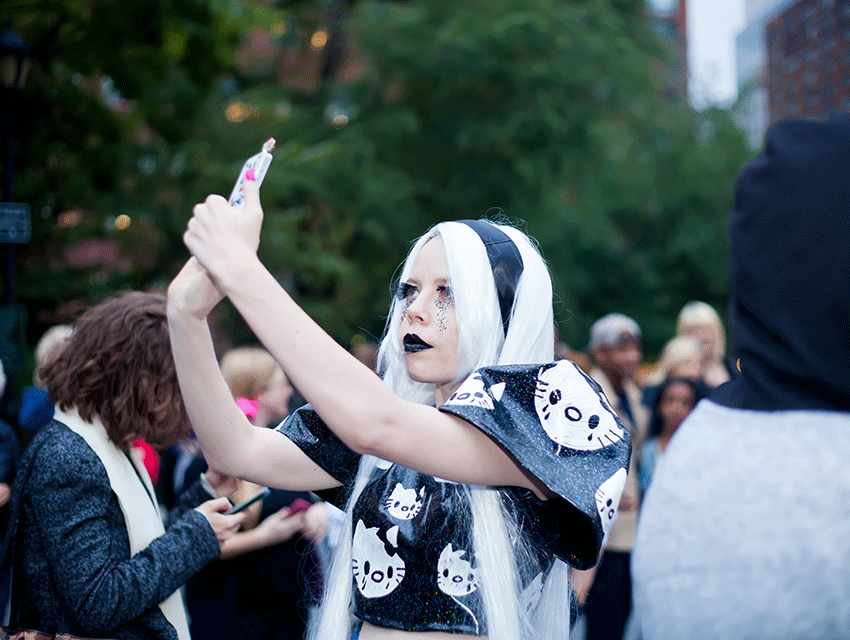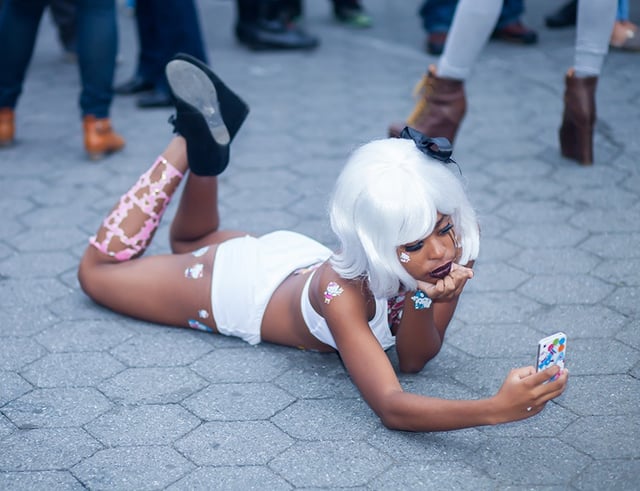Kate Durbin in the Gardens
Jesy Odio
5/15/2015
I met artist Kate Durbin at the Huntington Garden on a Sunday afternoon. I can’t stop thinking about what she was wearing: soft blue tights with images of cherubs printed on them, underneath a RED Valentino knock-off dress with swans on the collar. She carried a pink fake Hermès bag with bedazzled Disney princesses. There’s more. She told me, “I dressed up for you, but also to match the gardens.” We sat down among the rose buds and as soon as our conversation started, she put a blue wig on.
Jesy Odio: I came a month ago and the roses were not blooming yet.
Kate Durbin: I know, they have to go through their little dead period.
JO: Do you have a favorite garden?
KD: I mean I like all of the gardens for different reasons, I like the cactus garden, its very sci-fi, but it doesn’t match my work right now.
JO: Why did you decide to get a subscription at the Huntington Gardens?
KD: Part of it was that I live in Pasadena. So much of my work is about Los Angeles but I like having a little bit of distance to be able to make work about it. Sometimes when I come by myself, I’ll pick one spot, and sit there, and soak it in, sometimes I’ll meditate.
JO: I’ve been trying really hard to meditate. But, what scares me about meditation is the idea that you are supposed to not have any thoughts in my mind, because I enjoy thinking. Usually, I try to do things that I enjoy doing, so I feel like it’s too escapist for me. So, are you from Los Angeles?
KD: I am from Southern California. I grew up mostly in Orange County. Orange County has changed. It’s richer now than it used to be. We were very much a middle-class family. My best friend lived in Laguna Niguel. She was rich and she lived in a mansion with tennis courts. I would walk up the hill and play in her house, and lay on the floor under the chandelier, on the marble tiles. I had a strong sense of class difference, even as a child.
JO: I remember in an interview for The Hairpin, you said L.A. was a lot like the Internet. Do you still feel that way?
KD: L.A. is such an image-conscious place. And there’s this sense that your image is everything here and when you’re on the Internet, you are nothing but your avatar. There is also a sense in L.A. that you can create your own narrative. That’s the whole Hollywood ideal, right? Everyone would love to create their own story, have a dream, and be able to make it real. L.A. is a place that promises that. There are not that many cities or spaces that are like dream-factories. The Internet is like that too because you can construct your own narratives and choose your image and how to present yourself to the world. It’s hard to articulate, but they just feel the same to me. They are also both lonely places.


JO: I don’t know if you’ve ever read your own Wikipedia page. But I saw that it says you coined the term “teen girl tumblr aesthetic.” I love the authoritarian tone of the page. How do you feel about that?
KD: I love Wikipedia as this sheer space where anyone can contribute to this collective hive mind. It’s the way that history is created, anyway. I think it’s pretty accurate. No one was really using the phrase until I wrote that article for Hyperallergic.
JO: You have concluded your project Women as Objects. And Gaga as Stigmata is winding down. Looking back at those two online project, how did you feel about the process of gathering as it’s still happening?
KD: I ended “Women as Objects” at the end of 2013. I felt at that time I had archived enough material to capture that exciting period in Tumblr history when girls were making really amazing things. The world at large was ripping them off. The space was really occupied by teen girls. At the time that I started to wrap up the project, more people felt like they needed to have a tumblr. And I don’t think they understood what made Tumblr special as a platform, they were just using it as a promotional space. I feel the same way about Gaga Stigmata: we worked that project until the moment had passed. You know in sci-fi movies when a wormhole opens? You have like fifteen seconds to jump through the wormhole. The space between worlds has opened up and it is full of impossibilities. But it doesn’t stay open forever, you have a really short period of time and you can jump back and forth for a little while.
JO: I find the Internet to always be in friction between deciding to behave as a permanent space and an ephemeral place.
KD: One of my goals with Women as Objects was that I wanted to capture something that seemed important but something that people might miss because of various prejudices. A lot of people will get it in ten years, but a lot of it will be lost by then. Chanel has already taken ideas away from the girls. I wanted to archive that moment because it seemed important and because it might get lost. And I wanted to archive it in the same space in which it existed, tumblr. But in a way, there is no time on the Internet.
JO: I feel torn about thinking things too much and not thinking enough about them. Which is also why I’m conflicted about whether I want to continue my studies. As an instructor, how do you feel about being an artist and an academic?
KD: I’m applying for full time tenure track positions, and I’m not really sure how I will translate into that world. Things have become really specialized and they want people that do a specific genre in particular, and I do lots of things. The world has become restrictive and there is a huge lack of imagination. There is this sense that people need to fit into these boxes and be hyper-academic to be intellectual. They need only to go conferences and present papers and I just think that is the death of art. That is not the life for a free thinker. I’m interested in bringing art to everybody. I’m interested in doing intellectual things in a public forum. I think that brings a greater impact and value to the culture. I also believe education and access to academic research should be free, which apparently is really radical in academia now. We need to change all that. It’s not easy to straddle all those worlds, but I do it? It’s uncomfortable.
JO: And that’s exactly what I felt like you did with E! Entertainment, I felt like you were avoiding over-intellectualizing, but still finding meaning in reality TV.
KD: It brought comfort to me to think that you can evaluate something and not from an academic perspective. There’s a lot of pressure to work in that kind of way. But I don’t want to. Why tell them how to feel about reality TV? It’s more interesting to create an experience.


Image by Emily Raw of “Hello Selfie NYC”
JO: Before I let you go, I want to tell you how I came about interviewing you. I’m taking a class with professor Brian Kim Stefans. He teaches courses on screenwriting, and electronic literature and literature of Los Angeles. I went to his office hours and I felt like I could talk to him about your work it was the first time that I felt like there was a professor at UCLA that I could talk about my interests. And I kept bringing you up during our conversations. So I figured, ‘Why don’t I just ask Kate herself?’ I brought up the topic of selfies in class with Stefans and he said “all selfies are the same”.
KD: It depends on the person taking the selfie. And that’s what happened in my performance, Hello, Selfie! Everyone’s selfie meant something different to them. Talking to the performers afterwards, their experiences were varied. Some people found it pretty empowering, some people found it very anxiety-provoking. We have our own things going on. But of course we are all connected too, in the larger phenomenon of selfie-taking and this cultural moment. I don’t need to think my selfie is the same as Barack Obama’s selfie.
